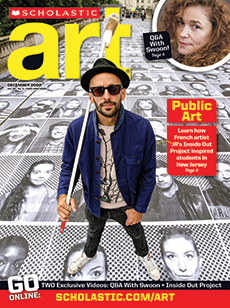Ella drops her chin and looks up from beneath her colorful hat with big, expressive eyes. Light plays across her gold glasses and she reveals just the hint of a smile. Who is the girl in the portrait on the cover? What is her story?
The artist, Bisa Butler, knows that she can create a narrative in quilted portraits like this one by placing clues throughout the work. The materials an artist uses—from paint and clay to found objects and even food—inherently have meaning. Butler carefully selects colors and fabrics that hold symbolic meaning for each of her portraits, revealing details about her subjects—and herself.
A girl looks up from beneath a colorful hat. She wears gold glasses, and a hint of a smile. Who is the girl in the portrait on the cover? What is her story?
Bisa Butler quilted the portrait out of fabric. She creates a narrative and places clues throughout the work. Her materials have meaning. Butler chooses fabrics in colors and patterns that are symbolic, which means they represent something about her subjects.
